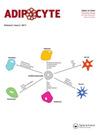肺腺癌中脂肪细胞因子及其相关lncrna的转录组分析揭示了与预后、免疫浸润和代谢特征的关联
IF 3.5
4区 生物学
Q2 ENDOCRINOLOGY & METABOLISM
引用次数: 20
摘要
肺腺癌(LUAD)是全球范围内导致癌症相关死亡的主要原因之一。脂肪细胞因子和长链非编码rna (lncRNAs)是癌症发生过程中不可或缺的参与者。我们对脂肪细胞因子的mRNA表达、单核苷酸变异、拷贝数变异和预后价值进行了泛癌分析。LUAD样本来自Gene Expression Omnibus (GEO)和the Cancer Genome Atlas (TCGA)数据库。同时,对培训、内部和外部队列进行分组。通过最小绝对收缩和选择算子回归分析、随机森林算法和Cox回归分析逐步筛选优化基因后,构建了一个与其他四个已建立的生存预测特征相比性能优越的脂肪细胞因子相关预后特征(ARPS)。在确定风险水平后,通过多种生物信息学方法探讨低、高危人群免疫微环境、免疫检查点基因表达、免疫亚型和免疫应答的差异。通过基因集富集分析(GSEA)确定了高风险和低风险亚组的异常途径。通过单样本GSEA选择与风险评分相关的免疫和代谢相关途径。最后,绘制具有满意预测生存概率的nomogram。本研究为临床治疗和科学研究提供了有意义的信息。本文章由计算机程序翻译,如有差异,请以英文原文为准。
Transcriptome analysis of adipocytokines and their-related LncRNAs in lung adenocarcinoma revealing the association with prognosis, immune infiltration, and metabolic characteristics
ABSTRACT Lung adenocarcinoma (LUAD) is amongst the major contributors to cancer-related deaths on a global scale. Adipocytokines and long non-coding RNAs (lncRNAs) are indispensable participants in cancer. We performed a pan-cancer analysis of the mRNA expression, single nucleotide variation, copy number variation, and prognostic value of adipocytokines. LUAD samples were obtained from the Gene Expression Omnibus (GEO) and The Cancer Genome Atlas (TCGA) databases. Simultaneously, train, internal and external cohorts were grouped. After a stepwise screening of optimized genes through least absolute shrinkage and selection operator regression analysis, random forest algorithm,, and Cox regression analysis, an adipocytokine-related prognostic signature (ARPS) with superior performance compared with four additional well-established signatures for survival prediction was constructed. After determination of risk levels, the discrepancy of immune microenvironment, immune checkpoint gene expression, immune subtypes, and immune response in low- and high-risk cohorts were explored through multiple bioinformatics methods. Abnormal pathways underlying high- and low-risk subgroups were identified through gene set enrichment analysis (GSEA). Immune-and metabolism-related pathways that were correlated with risk score were selected through single sample GSEA. Finally, a nomogram with satisfied predictive survival probability was plotted. In summary, this study offers meaningful information for clinical treatment and scientific investigation.
求助全文
通过发布文献求助,成功后即可免费获取论文全文。
去求助
来源期刊

Adipocyte
Medicine-Histology
CiteScore
6.50
自引率
3.00%
发文量
46
审稿时长
32 weeks
期刊介绍:
Adipocyte recognizes that the adipose tissue is the largest endocrine organ in the body, and explores the link between dysfunctional adipose tissue and the growing number of chronic diseases including diabetes, hypertension, cardiovascular disease and cancer. Historically, the primary function of the adipose tissue was limited to energy storage and thermoregulation. However, a plethora of research over the past 3 decades has recognized the dynamic role of the adipose tissue and its contribution to a variety of physiological processes including reproduction, angiogenesis, apoptosis, inflammation, blood pressure, coagulation, fibrinolysis, immunity and general metabolic homeostasis. The field of Adipose Tissue research has grown tremendously, and Adipocyte is the first international peer-reviewed journal of its kind providing a multi-disciplinary forum for research focusing exclusively on all aspects of adipose tissue physiology and pathophysiology. Adipocyte accepts high-profile submissions in basic, translational and clinical research.
 求助内容:
求助内容: 应助结果提醒方式:
应助结果提醒方式:


